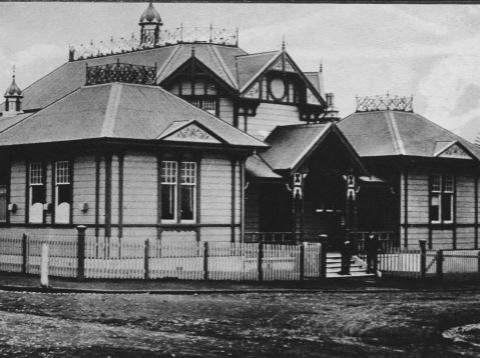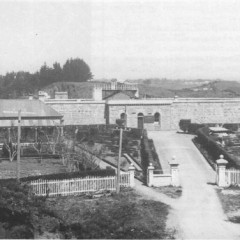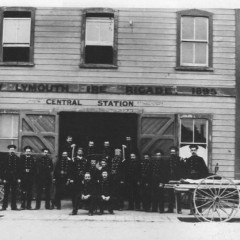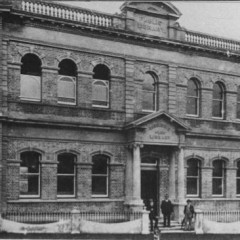10:2
and on the opening day the present Post Office car park still contained many thousands of litres of water. There were fears that opponents of the scheme might cause some disturbance, and a strong police guard was present. But the opening was a success, and the majority of the townspeople echoed the sentiment of one businessman: 'It has been worth waiting for.' Next problem: What to do about the rabbit warren of old buildings on the Robe Street site? These included the old government buildings, former houses, and old lock-up (the bars were still in the doors), the old Post Office-and the clock tower which for 60 years had dominated the town's skyline.
It was the demolition of the clock tower which caused the greatest controversy. Citizens had first began donating money for the clock in 1897 to mark that year's celebration of Queen Victoria's diamond jubilee, but it was not built until 1906. There were periodic complaints about its chimes, but it served the city well, and visitors and citizens came to regard it as the most dominant feature of the city. The first hint that all was not well came in 1944 when the Public Works Department declared that the picturesque 35-metre tower was an earthquake risk.
Tenders were called for its demolition, but the clock was left in peace until the mid-1960s when the site was being prepared for redevelopment as an open area. Petitions and lobbying then began in earnest. The city council cooled the situation somewhat in 1960 by deciding to keep the tower, subject to costs being acceptable. But after receiving an engineer's report that the structure would cost $36,000 to be made safe, the council voted nine to three to have it demolished. Shortly afterwards a newly-elected council narrowly countered a move to rescind the demolition order. A public subscription drive to 'Save the Clock Tower' gathered momentum, and a move to get the council to review its fate resulted in deadlock, the issue being blocked by the Mayor's casting vote. In 1968 the end came with a crash which was heard over most of the city. The mechanism of the clock had been carefully removed. It was mothballed and the council instructed that it be serviced regularly in case it was ever needed in some new structure. The Robe Street area was cleared and widened. Silver Street was closed to make way for a public garden which is enclosed by a multi-storeyed police station (built on the south side of Powderham Street in 1962), an imposing courthouse (1967) and the Atkinson Building which houses Government departments (1968). Statistics tell the story of the growth of the New Plymouth branch of the New Zealand Post Office (the name was changed from the Post and Telegraph Department in 1959). In 1980 its engineering and administra- tive staff of about 800 maintained facilities for more than 16,000 telephone subscribers who made nearly two million toll calls and sent and received 15,000 telegrams; 150,000 parcels and more than 12 million letters were handled.
'Prospectus: The Settlers of New Plymouth have so frequently ex- pressed the wish to have a Newspaper, that argument to prove the utility of a Journal to the interests and well-being of the Colony is superfluous. Arrangements have been completed to meet the wishes of the Colonists. The principles and manner in which it is proposed to conduct a newspaper, under the title of the Taranaki Herald, will be briefly explained. It is intended that the Taranaki Herald shall be emphatically A PAPER FOR THE SETTLERS:-to promote their prosperity and improvement, moral and physical, agricultural and commercial-to develop the resources of the district, and its advantage as a colonizing field. These will be the primary objects ever present in the minds of its Conductors . ' This extract from Vol. 1. No.1, of the Taranaki Herald on August 4, 1852, the oldest surviving newspaper in New Zealand, and the first in Taranaki, outlined the intentions of the founders, William Collins and Garland William Woon, who, in addition to being the 'Conductors' (a term which the paper used for many years to indicate the policy- makers) comprised the literary, advertising, printing and delivery staff, with William Morgan Crompton the editor. Other New Zealand centres had newspapers either immediately on settlement or shortly afterwards, but New Plymouth had to wait for 11 years before being provided with such an amenity. The little town had not been entirely without a news service-of a kind. For several years there had appeared on the approaches to a wooden bridge spanning the Huatoki Stream in Devon Street, a noticeboard which was mainly used as an advertising sheet. A 'For Sale' notice once proclaimed that a clergyman sought to dispose of 'that redoubtable pony, Pompey, with all the characteristics of a horse, mule and donkey-Apply at the Parsonage'; there was a 'Cottage for Sail', and once, 'to let, a commodious seven-roomed house. Apply to me on the premises.' No doubt most of the inhabitants knew who 'me' was, and where the commodious house stood, but a stranger could have been at a loss. ,br>
The noticeboard remained, a relic of the pre-news- paper age, until the bridge it flanked was replaced by a stone one in 1857. The Herald was conceived of politics. After Governor Grey's amended Constitutional Act had been adopted by the British Government, meetings of settlers were held to discuss the political implications of the new representation. At the New Plymouth meetings the townsfolk stressed the need, already met in other centres, for a newspaper in which to air their grievances, and Collins, who had been a printer on the London
Morning Post, was sent to Auckland in an endeavour to obtain' some printing material'. Before leaving London he had investigated a report of a paper being started in the town by J. J. Weston, who had considered bringing the necessary equipment from Britain, but who had dropped the idea when he learnt from Charles Hursthouse that arrangements had already been made to start a Taranaki paper. This was incorrect, but in itself was a pointer to the need for confirmation or denial of rumours-and what better medium than the media! Collins, after much difficulty, obtained some second-hand type and an old Albion press (now held in the Taranaki Museum), parts of which were missing. He brought it all by sea to New Plymouth where he set it up in an old shed lent by William Lakeman, which stood on part of the site now occupied by Whites Ltd in Devon Street, not far from the town's noticeboard. After much trial and error with the primitive equipment the first issue of the Taranaki Herald appeared on Wednesday, 4 August, 1852.
The four-page tabloid contained many advertisements, shipping news, political propaganda, 'human interest' stories, industrial and commer- cial articles and a report on a 'melancholy and fatal accident' which occurred in Brighton, England, when a heavy gate had crashed down. One item of great interest was the notice of the marriage of the joint-proprietor, Woon, to Ann George, which had taken place the previous week. Among the three 'Ieaderets' was one referring to the forthcoming election, and editor Crompton pointed out that 'the Colonists of New Zealand are about to exercise for the first time the duties and privileges which attached to a representative form of Government' . The 'conductors' did not intend that New Plymouth should be the limit of the paper's influence, for it was stated that 'The Taranaki Herald (weekly, at seven and sixpence a quarter or thirty shillings a year, payable in advance) will be extensively circulated in Sydney, Mel- bourne, Adelaide, Geelong, Hobart Town, Launceston, Cape Town and other European settlements in ,the Pacific and also in the Mother Country.' This apparently extravagant promise was to be honoured within a decade, when the land wars made Taranaki a centre of European interest, and Woons faithful reporting of the various campaigns was eagerly read by newspaper subscribers throughout the English-speaking world.
Woon, after a brief absence in Wanganui, acquired full control of the paper in 1854, following two years of production problems and editorial differences as a result of which Crompton withdrew in favour of Richard Pheney. Crompton had an abrasive pen and his resignation followed an offending leading article in which he repudiated the New Zealand Company's claim on the unsold land in the settlement and objected to the 'imperial legislation' ,proposing that the New Zealand settlers make good the 'Land Company's' loss. Pheneys style, though not as abrasive as Crompton's, soon aroused hostility with criticism of the central government's policy on the land problem and its tardiness in 'defending' New Plymouth, and in November 1856 another editorial change occurred. The triennial elec- tions for provincial government, the second in the settlement's history, were approaching, and the Herald changed from the advocacy of the sitting Superintendent, Charles Brown, to that of George Cutfield. Pheney , opposing the change ordered by Woon, resigned, and friends of Brown started the Taranaki News on May 14, 1857, appointing Pheney its first editor. The Herald's volte-face was astounding. From warm support of Brown, it turned to critic, labelling him a 'modern Machiavelli- entangled in his own coils' . Brown, as the News proprietor, was not slow in hitting back.
Thus began a newspaper 'feud' which continued in varying degrees of editorial and commercial hostility and 'friendly' competition, even after the amalgamation of the two papers more than a century later. Woon undertook the editorship of the Herald, calling upon friends to assist in writing editorials. Among these were W. Halse, solicitor and Commissioner of Crown Lands, and Richard Brown, a merchant and a member of the Provincial Council. Brown was editor for a time until he resigned to take a commission. He died on active service on August 31, 1860. One of the most valuable legacies left by Woon was his Journal of Events, a day-to-day diary of an informed member of the beleaguered garrison of New Plymouth, from March 3,1860, to March 30,1861, and resumed on March 4,1863, on the eve of the rise of Hauhauism. It was printed weekly in the Herald, and although it has little literary pretension, for Woon was a printer, not a writer, it is rich in historical material. In it he recorded the preparations for fighting, the arrival of British troops, the evacuation of women and children to Nelson (Tads over 16 may be excepted') problems with rationing and various military proclamations. He incurred the displeasure of the military authorities on May 12, 1860, by an article criticising the defence of the town with the result that under the provisions of prevailing martial law he was accused of writing material which could 'give information to the enemy'. The Herald appeared with the offending paragraph missing, the white space being filled with fullpoints. It was the first and only time the Herald was censored. Arthur Atkinson, brother of Harry (later Sir Harry Atkinson, Premier of New Zealand) joined Woon in partnership in 1864, but the arrangement did not prosper and after two years Atkinson left to enter politics and then law.




